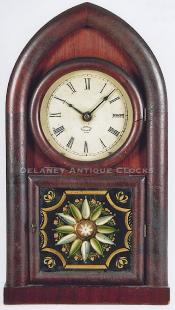Chauncey Jerome of New Haven, Connecticut. A Beehive mantel clock. TT-157.
This is an excellent example of a Connecticut beehive mantel or shelf clock. It was made by Chauncey Jerome of New Haven, Connecticut. The case is constructed in mahogany and retains its original finish, which has darkened over its lifetime. This case sits on a simple base. A rounded molding conforms to the general shape of the case. The front is fitted with a door. It is hinged on the right. The upper section is circular and fitted with clear glass. Through this, one views the dial. The lower section is fitted with a reverse-painted tablet. The artwork is in excellent original condition. The colors are still in excellent condition. The backboard is covered in its original blue paper label. The dial is painted on tin and is original to this clock. The Maker’s Name and working location are painted here. It reads, “C. JEROME / NEW HAVEN / CONN.” The time track features Roman hour figures. The movement is constructed in brass and is spring wound. It is designed to run for eight days on a full wind and to strike each hour on a wire gong located inside the case. The front plate is also die-stamped by the Maker.
This example is considered to be the standard size. It measures approximately 19 inches tall, 10.5 inches wide and 3.75 inches deep.
It was made circa 1875.
Please note that this clock was photographed before the movement was serviced.
Inventory number TT-157.
Chauncey Jerome was born in 1793 in Canaan, Connecticut, the son of a blacksmith and a nail-maker. He has a storied history in the Connecticut clock industry, becoming one of our nation's giant employers and producers during his lifetime. His autobiography has been reprinted and is available at the American Clock and Watch Museum in Bristol, CT. It is a worthy read.
Chauncey began his clockmaking career as a joiner. First, making wooden dials for tall clocks, and then in 1816, he went to work for Eli Terry. Jerome made the cases for Terry's Pillar & Scroll shelf clocks. Soon, he decided to work for himself, making cases and trading them with Terry for his movements. By 1822, Jerome moved his business to Bristol. He was an innovator in clock case construction and design. In 1842, he again moved his shop, this time to New Haven.
In 1850, Jerome formed the Jerome Manufacturing Company. In 1853, he formed the New Haven Clock Co.
Throughout his lifetime, he weathered numerous business disasters and windfalls. He was a well-respected citizen and served in the state legislature and as mayor of New Haven. He died penniless in 1868.






